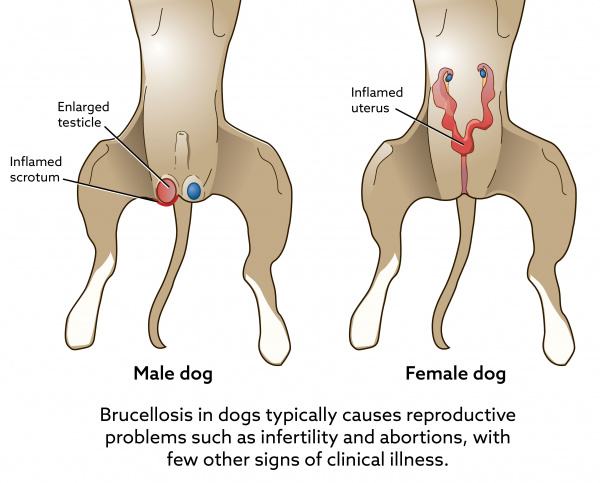What Are The Symptoms Of Brucellosis In Animals
What is canine brucellosis?
Canine brucellosis is a contagious bacterial infection caused by the bacterium, Brucella canis (B. canis). This bacterial infection is highly contagious between dogs. Infected dogs usually develop an infection of the reproductive system, or a sexually transmitted disease.
Dissimilar species of Brucella infect sheep, goats, cattle, deer, elk, pigs, and other animals.
What are the signs of brucellosis? 
Brucellosis in dogs typically causes reproductive problems such as infertility and abortions, with few other signs of clinical affliction. The affliction is almost common in sexually intact adult dogs.
"Brucellosis in dogs typically causes reproductive problems such as infertility and abortions, with few other signs of clinical illness."
Male dogs infected with brucellosis develop epididymitis, an infection in part of the testicle. A dog with a newly acquired infection will ofttimes take an enlarged scrotum or an enlarged testicle and may have a skin rash on the scrotum. The dog may be infertile. In chronic or long-standing cases, the testicles volition cloudburst or become shrunken.
Female dogs infected with brucellosis develop an infection of the uterus; causing her to be infertile, have difficulty getting pregnant, or she may arrest in the tardily stages of pregnancy. She oftentimes has a persistent vaginal discharge. Typically, a pregnant domestic dog with brucellosis will abort at 45-55 days of gestation or volition give birth to stillborn or weak puppies that may dice a few days after birth.
During the early on stages of brucellosis, enlarged lymph nodes are common. Occasionally, B. canis will infect the intervertebral discs, eyes, kidneys, or brain. If the leaner infects these other tissues, the signs volition exist related to the bodily organisation that is infected.
How is canine brucellosis spread?
Big numbers of B. canis bacteria are shed in the genital secretions (semen or vaginal discharges) of an infected dog. Smaller amounts of leaner may likewise be shed in the canis familiaris's urine or saliva. Afterward a female dog aborts a pregnancy because of brucellosis, she will continue to discharge fluids infected with the leaner for four-6 weeks after the abortion.
Dogs are exposed to the disease via contact with infected bodily fluids. Although the most common road of infection is oral (i.e., from licking contaminated urine or discharges from the reproductive tract or licking or chewing placental material or aborted fetuses), dogs can likewise pick upward an infection through sexual transmission, inhalation (sniffing contaminated urine or other discharges), or through other mucous membranes such as the eyes.
How is canine brucellosis diagnosed?
The infection is usually diagnosed by a blood test. The near common claret test is called a rapid slide agglutination test or RAST, and it can discover infections later on three to four weeks. This test is used for screening of breeding dogs, and negative tests are reliable unless the dog has been recently exposed to the disease. False-positive tests are relatively common, and any dog that tests positive with the RAST test should have the affliction confirmed with an advanced test chosen an agar gel immunodiffusion test (AGID), which volition place infected animals betwixt 12 weeks and 1 year post-infection.
What is the handling for canine brucellosis?
Although antibiotics (nearly frequently minocycline or doxycycline, possibly enrofloxacin) tin be used to help control the infection, no handling is completely effective at eliminating the bacteria, and any canis familiaris that has been infected with B. canis should exist considered to be infected for life. Even if the acute infection can be controlled with antibiotics, the dog may shed leaner intermittently for the rest of its life.
"Any dog that has been infected with B. canis should be considered to be infected for life."
Surgical sterilization of the infected dog will decrease shedding of the organisms into the environs, thereby reducing the risk to other dogs.
How can brucellosis be controlled?
Brucellosis in dogs is a rare disease in Canada. Information technology is more prevalent in some areas of the United States, such as the southern United states of america, and in other parts of the world. Since the disease is a major threat to the breeding capability of dogs, all dogs used for breeding purposes should exist tested regularly (due east.g., every iii-half dozen months, depending on exposure to other dogs), and new dogs should never be introduced into a kennel state of affairs until they have been quarantined for 8-12 weeks and then tested for the disease. Almost experts recommend performing two blood tests four weeks autonomously, near the end of the quarantine period.
In the United States, brucellosis is a reportable disease, meaning that the illness is of great public wellness importance, and veterinarians and physicians are required to study all positive cases to federal authorities. Canine brucellosis is non reportable in Canada.
Am I at take chances for developing brucellosis from an infected dog? 
Brucellosis is a zoonotic disease, or a disease that tin can be transmitted from animals to humans. Although people can become infected by coming in contact with infected animals, it is uncommon for a person to get a brucellosis infection from a dog.
Breeders and veterinarians exposed to the blood or other secretions of infected animals are at an increased hazard of developing an infection; pet owners are not considered to be at take a chance for infection because they are less likely to come in contact with blood, semen, or uterine discharges from an infected dog.
However, people with compromised immune systems should avert contact with a dog that is diagnosed with brucellosis.
People who come in contact with convenance dogs, newborn puppies, or aborted fetuses should use circumspection and practice good sanitation. Whenever possible, clothing disposable gloves before treatment newborn puppies or cleaning an area where a canis familiaris has whelped. Afterward removal of the disposable gloves, wash your easily thoroughly with soap and water and rinse well.
Source: https://vcahospitals.com/know-your-pet/canine-brucellosis
Posted by: alemanmility.blogspot.com

0 Response to "What Are The Symptoms Of Brucellosis In Animals"
Post a Comment